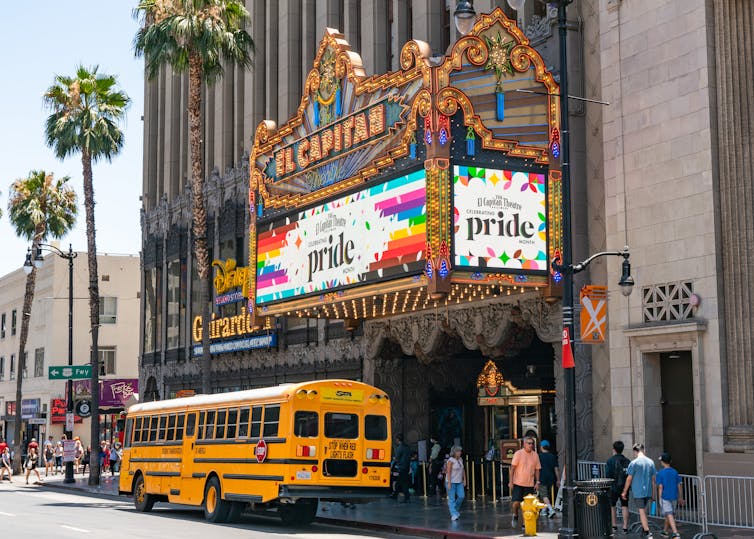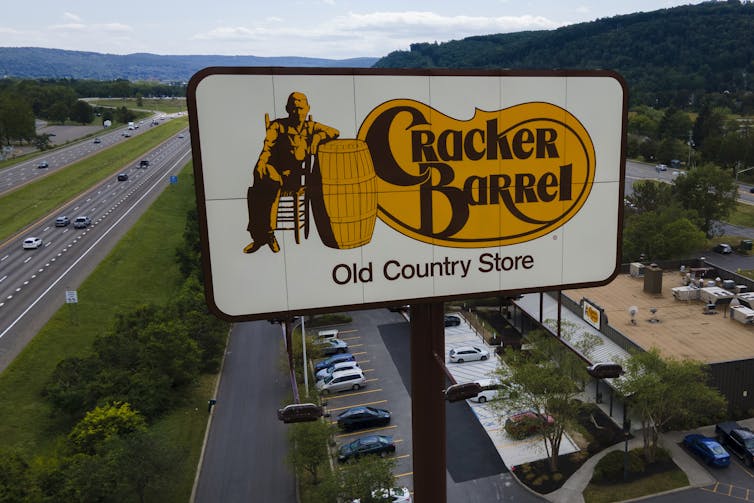Bad Bunny is the latest product of political rage — how pop culture became the front line of American politics
- Written by Adam G. Klein, Associate Professor of Communication and Media Studies, Pace University
When the NFL in September 2025 announced that Bad Bunny would headline the next Super Bowl[1] halftime show, it took only hours for the political outrage machine to roar to life.
The Puerto Rican performer, known for mixing pop stardom with outspoken politics[2], was swiftly recast by conservative influencers as the latest symbol of America’s “woke” decline[3].
Homeland Security Secretary Kristi Noem joined the critics[4] on conservative commentator Benny Johnson’s[5] podcast.
“Well, they suck, and we’ll win,” she said, speaking of the NFL’s choice. “And they’re so weak, we’ll fix it.”
President Donald Trump called Bad Bunny’s selection “absolutely ridiculous[6]” on the right-wing media outlet Newsmax. And far-right radio host and prominent conspiracy theorist Alex Jones[7] fanned the flames of anti-NFL sentiment online. Hashtags like #BoycottBadBunny spread on the social platform X, where the performer was branded a “demonic Marxist[8]” by right-wing influencers.
Then it was Bad Bunny’s turn. Hosting “Saturday Night Live,” he embraced the controversy, defending his heritage and answering his critics in Spanish before declaring[9], “If you didn’t understand what I just said, you have four months to learn.”
By the time NFL Commissioner Roger Goodell addressed the backlash[10], the outrage had already served its purpose. The story had become another front in the culture war between left and right, complete with nationalism, identity politics, media spectacle and performative anger.
As a researcher of propaganda[11], I’ve spent the past three years tracking these cycles of outrage across social platforms and partisan media, studying how they hijack the national conversation and spill into local politics. My recent book, “"Populism, Propaganda, and Political Extremism,”[12] is guided by a single question: How much of our political outrage is really our own?
Outrage before the event
Culture wars have long shaped American politics, from battles over gun rights[13] to disputes over prayer in schools[14], book bans[15] and historical monuments[16].
Sociologist James Davison Hunter[17] coined the term “culture wars” to describe a recurring struggle, not just over social issues but over “the meaning of America[18].” These battles once arose from spontaneous events that struck a cultural nerve. An American flag is set ablaze, and citizens quickly take sides as the political world responds in kind.
But today that order has reversed. Culture wars now begin in the political sector, where professional partisans introduce them[19] into the public discourse, then watch them take hold. They’re marketed to media audiences as storylines, designed to spark outrage and turn disengaged voters into angry ones.
One clear sign that outrage is being manufactured is when the backlash begins long before the designated “controversial event” even occurs.
In 2022, American audiences were urged by conservative influencers[20] to condemn Pixar’s film “Lightyear” months before it reached theaters. A same-sex kiss turned the film into a vessel for accusations of Hollywood’s “culture agenda[21].” Driven by partisan efforts, the outrage spread online, mixing with darker elements and eventually culminating in neo-Nazi protests[22] outside Disney World.
This primed outrage appears across the political spectrum.
Last spring, when President Donald Trump announced a military parade in Washington, leading Democrats quickly framed it as an unmistakable show of authoritarianism[23]. By the time the parade arrived months later, it was met with dueling “No Kings” demonstrations across the country[24].
And when HBO host Bill Maher said in March that he would be dining with Trump, the comedian faced a preemptive backlash[25], which escalated into vocal criticism from the political left[26] before either of the men raised a fork.

Today, few things are marketed as aggressively as political anger, as seen in the recent firestorm against Bad Bunny. It’s promoted daily through podcasts[28], hashtags, memes[29] and merchandise[30].
Increasingly, these fiery narratives originate not in politics but in popular culture, providing an enticing hook for stories about the left’s control over culture[31] or the right’s claims to real America[32].
In recent months alone, outrage among America’s polarized political bases has flared over a Cracker Barrel logo change[33], “woke Superman[34],” Sydney Sweeney’s American Eagle ad[35] and, with Bad Bunny, the NFL’s Super Bowl performer[36].
Platforms like X and TikTok deliver the next diatribes, amplified by partisan influencers and spread by algorithms. From there, they become national stories, often marked by headlines promising the latest “liberal meltdown[37]” or “MAGA tantrum[38].”
But manufactured outrage doesn’t stop at the national level. It surfaces in local politics, where these stories play out in protests and town halls.
The local echo
I wanted to understand how these narratives reach communities and how politically active citizens see themselves within this cycle. Over the past year, I interviewed[39] liberal and conservative activists, beginning in my hometown, where opposing protesters[40] have faced off every Saturday for two decades.
Their signs echo the same narratives that dominate national politics: warnings about the left’s “woke agenda” and charges of “Trump fascism.” When asked about the opposition, protesters reached for familiar caricatures. Conservatives often described the left as “radical” and “socialist,” while those on the left saw the right as “cultlike” and “extremist.”
Yet beneath the anger, both sides recognized something larger at play – the sense that outrage itself is being engineered. “The media constantly fan the flames of division for more views,” one protester said. Across the street, his counterpart agreed: “Politics is being pushed into previously nonpolitical areas.”

Both camps pointed to the media as the primary culprit, the force that “causes and benefits from the outrage.” A liberal activist observed, “Media tend to focus on whoever shouts the loudest.” A conservative demonstrator agreed: “I feel like the media promotes extreme idealists. The loudest voice gets the most coverage.”
“It’s been a crazy few years, moving further to the extremes, and tensions are always rising,” one protester reflected. “But I think people are realizing that now.”
Across the divide, protesters understood that they were participants in something larger than their weekly standoffs, a system that converts every political difference into a national spectacle. They saw it, resented it and yet couldn’t escape it.
That brings us back to Bad Bunny. The anger that Americans are encouraged to feel over his selection – or in defense of it – keeps the country locked in its corners. Studies show that as a result of these cycles, Americans on the left and right have developed an exaggerated sense[42] of the other side’s hostility, exactly as some political demagogues[43] intend.
It has created a split screen of the country, literally in the case of Bad Bunny. On Super Bowl night, there will be dueling halftime shows. On one screen, Bad Bunny will perform for approving viewers. On the other, the conservative nonprofit Turning Point USA[44] will host its “All-American Halftime Show[45]” for those intent on tuning Bad Bunny out.
Two screens. Two Americas.
References
- ^ Bad Bunny would headline the next Super Bowl (www.nfl.com)
- ^ mixing pop stardom with outspoken politics (www.wired.com)
- ^ America’s “woke” decline (www.mediamatters.org)
- ^ Kristi Noem joined the critics (thehill.com)
- ^ Benny Johnson’s (www.tiktok.com)
- ^ absolutely ridiculous (variety.com)
- ^ Alex Jones (x.com)
- ^ demonic Marxist (x.com)
- ^ answering his critics in Spanish before declaring (www.youtube.com)
- ^ addressed the backlash (x.com)
- ^ a researcher of propaganda (scholar.google.com)
- ^ "Populism, Propaganda, and Political Extremism,” (www.routledge.com)
- ^ gun rights (www.cato.org)
- ^ prayer in schools (www.pewresearch.org)
- ^ book bans (abcnews.go.com)
- ^ historical monuments (www.pbs.org)
- ^ Sociologist James Davison Hunter (www.wbur.org)
- ^ the meaning of America (www.politico.com)
- ^ introduce them (kansasreflector.com)
- ^ urged by conservative influencers (www.vanityfair.com)
- ^ culture agenda (www.breitbart.com)
- ^ neo-Nazi protests (www.nbcnews.com)
- ^ show of authoritarianism (thehill.com)
- ^ “No Kings” demonstrations across the country (abcnews.go.com)
- ^ preemptive backlash (x.com)
- ^ political left (san.com)
- ^ AaronP/Bauer-Griffin/GC Images (www.gettyimages.com)
- ^ podcasts (x.com)
- ^ memes (www.instagram.com)
- ^ merchandise (www.teepublic.com)
- ^ control over culture (dailycaller.com)
- ^ claims to real America (www.theatlantic.com)
- ^ logo change (www.wsj.com)
- ^ woke Superman (www.nbcnews.com)
- ^ American Eagle ad (reason.com)
- ^ Super Bowl performer (www.musictimes.com)
- ^ liberal meltdown (nypost.com)
- ^ MAGA tantrum (www.salon.com)
- ^ interviewed (www.taylorfrancis.com)
- ^ opposing protesters (tbrnewsmedia.com)
- ^ AP Photo/Ted Shaffrey (newsroom.ap.org)
- ^ exaggerated sense (doi.org)
- ^ political demagogues (news.harvard.edu)
- ^ the conservative nonprofit Turning Point USA (theconversation.com)
- ^ All-American Halftime Show (nypost.com)
Authors: Adam G. Klein, Associate Professor of Communication and Media Studies, Pace University




